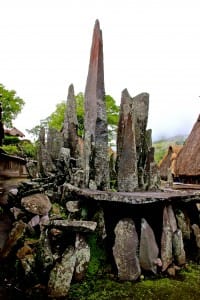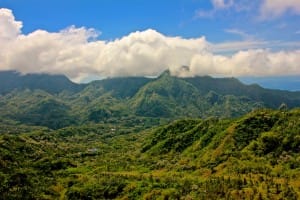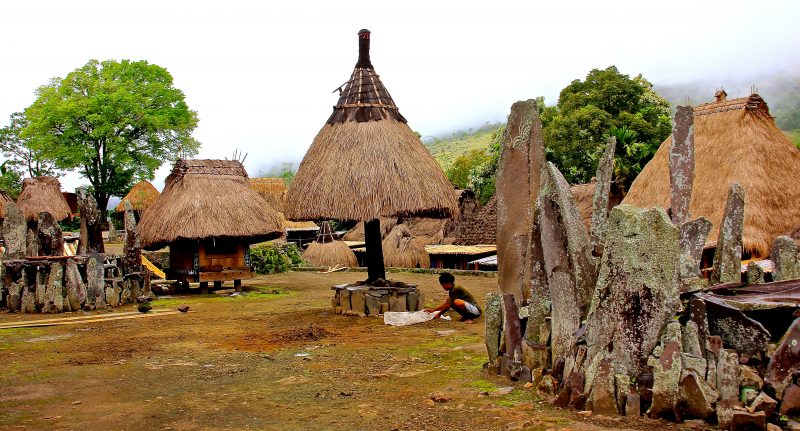On finally having the chance to visit Bajawa, Flores, I noticed “Jawa” in the name. When I finally had the chance to visit Bajawa’s famous traditional houses in Bena, I learned that this was no coincidence.
Despite my first impression however, I did not immediately make the connection: the traditional houses of Bena do bear some exterior resemblance to the Javanese joglo, but they are also very different.
Originally from Pati—a north coastal settlement in Central Java—the ancestors of Bena sailed to Flores 1,050 years ago. Their ship was stranded on the southern coast of central Flores, and its deck became the neighbourhood of Bena. Descending downhill towards Bena, you can see the traditional houses lined up in a pair of curves in the shape of a ship deck.
The neighbourhood of Bena is named after one of its seven founding fathers from Java. Due to the forefathers’ practice of polygyny, the people of Bena trace common ancestry with the people of Maubena, Likowali, Benaliwo and Watujaji. Men leave their parents’ homes to live with their wives’ first families—and if the first wife gives her consent, to spend time in the homes of his other wives as well.
There are 45 traditional houses in Bena, six belonging to each of the nine clans that live there. Made of wooden walls, reed roofs and bamboo floors, these traditional houses say much about the local concepts of gender upon which the culture is based.
In the space between the two curvaceous rows of houses, there are umbrella-shaped masculine altars called ngadu and feminine altars called bagha, which look like miniature elevated houses with pigeonholes in the centre.

Rituals involving ngadu and bagha are conducted by a woman’s household. The pole of ngadu is used for tying up livestock. The rope, pe’u, symbolises children born out of the man and woman’s union, forever binding them together.
To marry a woman in Bena, a man must first commit to a three-year premarital service to his father-in-law to be, then present an offering of coconuts, chicken, betel leaves and areca nuts to his wife-to-be’s family. If they accept the proposal, the woman’s family slaughters a pig and hosts a feast called zeza. Then they welcome the groom by seating him on an altar in the centre of the home, and he officially becomes a husband.
While most residents of Bena today have converted to Catholicism, the zeza wedding and ngadu-bagha rituals originate from the pre-Christian practice of ujukuwi. In the local Ngada language, ujukuwi refers both to an offering of prayer, and the name of the faith. Adherents of ujukuwi worship a “Heavenly Father” called Nitu Gale, and lift up prayers to him through a personification of “Mother Earth”.
Pak Kasmir, a local elder who guides for a small fee told me, “People tend to generalise such indigenous beliefs as animism, but I refuse to label Ujukuwi as such. There were many generations here before Catholicism reached Flores, we have already known God and prayed to him.” Pak Kasmir claims to have studied Islamology and lived in Java for 50 years with his wife, a native of Purworejo.
Tradition has it that Bena was first built by a giant named Dakhe, who carried magical rocks from nearby Mount Inerie to erect the famous Neolithic altar watunabe in the centre of the village. Among dozens of standing stones lies a large dolmen which resembles a dining table with a round basin in the centre—somewhat like a cupholder on the folding table of an aircraft seat.
“It is on this dolmen that we lift up our ujukuwi to our ancestors. This is where the name Bajawa comes from: it means ‘plate from Java’,” said Pak Kasmir.
Dakhe was believed to be a man of great strength. “He’s a little bit like Goliath. But I think Goliath must have been smaller because David so easily struck him down with a stone. You can’t do that to Dakhe. If Dakhe wants fish, he walks in the sea. He grabs sharks by the tail and slams them. Carrying the rocks that made this watunabe was child’s play for him,” said Pak Kasmir.
We then toured a traditional house. “The traditional house of Bena has three storeys. But people from Java often misunderstand this: it’s not three storeys high but three storeys inside,” explained Pak Kasmir.

The first storey is the alfresco wooden terrace where residents perform daily activities, such as weaving and woodworking, and flaunt their wealth in the form of bull horns and pig tusks from previous celebration ceremonies. The second storey is the multipurpose central room where the family sleeps at night and where the mataraga altar is located. Behind the altar is a small sliding door to the third storey, where one must kneel and bow. The third and most interior storey of the house is a kitchen with a traditional wooden furnace.
A good time to visit Bena is on December 27 during the Reba celebrations. Reba, traditionally celebrated on December 15, is the Ngada New Year. However, since December 15 would interfere with Catholic commitments to the pre-Christmas advent, Reba celebrations are now postponed until after Christmas, and just before the Christian New Year.
I completed my visit to Bena by climbing the southern end of the neighbourhood where a small shrine to Mother Mary looked out to the lush hills of Surelaki. Deep shades of nature’s blue left me questioning where the sky ends and Earth starts. As the soft, peaceful breeze plays with my hair, I say goodbye to Bena with images of ancient Javanese sailors and giants moving mountains, establishing a great settlement whose legacy has lasted a millennium.
Fast Facts
Country: Indonesia
Province: Nusa Tenggara Timur (NTT)
Largest City: Kupang (capital of NTT, Timor Island)
Land area: 566 islands, 47,349.9 km2
Highest elevation: Flores: Ranakah – 2,350 metres amsl
Population: NTT – 4,899,260 (BPS 2012 estimate)
How to get there: Daily flights to Ende from Kupang, Surabaya, and Denpasar, the 4-5 hour drive from Ende to Bajawa.
Alternatively, fly from Bali into Labuan Bajo (8-9 hour drive) or Maumere (7-8 hour drive).
What to bring: Hat, sunglasses, sunscreen, polite attire (covered shoulders and knees), camera, cash for entrance and guide fees, cigarettes to offer local men (especially when photographed).




